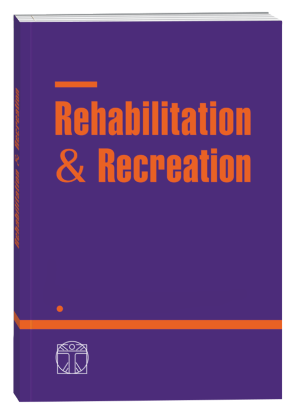REABILITATION METHODS OF RECOVERY IN ARTHRITIS OF THE KNEE JOINT
DOI:
https://doi.org/10.32782/2522-1795.2022.12.2Keywords:
arthritis, rehabilitation, massage, physiotherapy, recoveryAbstract
According to statistics, about 2% of the population of Ukraine suffer from arthritis. At the same time, the disease develops much more often in women: there are four women for every man. Arthritis is an age-related joint disease, but recently, a rare form of arthritis is also affecting teenagers, children, and young adults between the ages of 18 and 30. Living with chronic arthritis is very difficult, and sometimes unbearable: limitation of mobility can worsen the quality of lif, depriving a person of work, full rest and even peaceful sleep. Arthritis of the knee joint is one of the many diseases represented by inflammation of its structure. The occurrence of arthritis is associated with the influence of many factors that determine the type of disease. It intensifies the most at night, so the quality of sleep deteriorates, patients become lethargic, tired, and constantly nervous. Advanced arthritis can lead to arthrosis, which means irreversible joint deformity and constant pain when moving. Despite the fact that arthritis of the knee joint is considered a disease of the elderly, in recent years it is increasingly diagnosed in people over 35 years old. The main danger of this disease is that it develops without proper treatment. As a result, this leads to significant limitations in movement. Factors that cause arthritis include genetics, smoking and caffeine abuse, bacterial and viral infections, hormonal imbalances, surgery, trauma, and even food allergies. According to international data, the survival of arthritis patients who have not achieved clinical and laboratory remission is comparable to the survival of such serious diseases as diabetes, acute cerebrovascular accident, coronary heart disease. Compared to people of the same sex and age without arthritis, patients with this lesion have a 2.5 times higher mortality rate, and the patient's life expectancy is reduced by 5-10 years, often for various reasons. The disease is not only a serious medical problem due to the insufficient effectiveness of treatment, but it is also of great social importance due to the high frequency of increased incapacity and disability. Patients are concerned about increased mobility restrictions and side effects of treatment. They are afraid of losing the ability to serve themselves, which changes self-awareness and negatively affects all areas of life of these patients: work, recreation, environment, behavior, family relationships, sexual activity. The goal of physical rehabilitation for arthritis of the knee joint is to improve the mobility and blood supply of the joint. To achieve the effect, there is need to reduce pain and swelling, relieve spasms and strengthen muscles. Correct treatment will help to prevent the degeneration of cartilage and the development of joint diseases in the future. Therefore, for the effective treatment and recovery of such patients, it is recommended to create a team of specialists (doctor, pharmacologist, psychologist, nutritionist, physiotherapist and occupational therapist) who will accompany the patient at all stages of treatment (hospitals, sanatoriums, at home).
References
Jacobs, H., Seeber, G. H., Allers, K., & Hoffmann, F. (2021). Utilisation of outpatient physiotherapy in patients following total knee arthroplasty–a systematic review. BMC musculoskeletal disorders, 22(1), 1-11.
Abdel-Aziem, A. A., Soliman, E. S., Mosaad, D. M., & Draz, A. H. (2018). Effect of a physiotherapy rehabilitation program on knee osteoarthritis in patients with different pain intensities. Journal of physical therapy science, 30(2), 307-312.
Clode, N. J., Perry, M. A., & Wulff, L. (2018). Does physiotherapy prehabilitation improve pre-surgical outcomes and influence patient expectations prior to knee and hip joint arthroplasty? International journal of orthopaedic and trauma nursing, 30, 14-19.
Atalay, S. G., Durmus, A., & Gezginaslan, Ö. (2021). The Effect of Acupuncture and Physiotherapy on Patients with Knee Osteoarthritis: A Randomized Controlled Study. Pain Physician, 24(3), E269.
Holm, I., Pripp, A. H., & Risberg, M. A. (2020). The active with OsteoArthritis (AktivA) physiotherapy implementation model: a patient education, supervised exercise and selfmanagement program for patients with mild to moderate osteoarthritis of the knee or hip joint. A National Register Study with a two-year follow-up. Journal of Clinical Medicine, 9(10), 3112.
Shukla, M., & Goyal, M. (2019). Physiotherapy treatment for osteoarthritis knee: A review of literature. ZENITH International Journal of Multidisciplinary Research, 9(1), 129-134.
Barker, K. L., Room, J., Knight, R., Dutton, S. J., Toye, F., Leal, J., … & Lamb, S. E. (2020). Outpatient physiotherapy versus home-based rehabilitation for patients at risk of poor outcomes after knee arthroplasty: CORKA RCT. Health Technology Assessment (Winchester, England), 24(65), 1.
Tani, K., Kola, I., Dhamaj, F., Shpata, V., & Zallari, K. (2018). Physiotherapy effects in gait speed in patients with knee osteoarthritis. Open access Macedonian journal of medical sciences, 6(3), 493.
Teo, P. L., Hinman, R. S., Egerton, T., Dziedzic, K. S., Kasza, J., & Bennell, K. L. (2020). Patient-reported quality indicators to evaluate physiotherapy care for hip and/or knee osteoarthritis-development and evaluation of the QUIPA tool. BMC musculoskeletal disorders, 21(1), 1-11.
Fatoye, F., Yeowell, G., Wright, J. M., & Gebrye, T. (2021). Clinical and cost-effectiveness of physiotherapy interventions following total knee replacement: a systematic review and metaanalysis. Archives of Orthopaedic and Trauma Surgery, 141(10), 1761-1778.
Downloads
Published
How to Cite
Issue
Section
License

This work is licensed under a Creative Commons Attribution-NonCommercial-NoDerivatives 4.0 International License.











